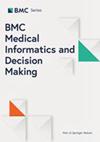基于机器学习的急性淋巴细胞白血病患者死亡率和复发预后因素评估:一项比较模拟研究
IF 3.3
3区 医学
Q2 MEDICAL INFORMATICS
引用次数: 0
摘要
预测急性淋巴细胞白血病(ALL)患儿的死亡率和复发率对于有效治疗和后续管理至关重要。急性淋巴细胞白血病是一种常见且致命的儿童癌症,常常在缓解后复发。在这项研究中,我们旨在应用和评估基于机器学习的模型来预测儿童 ALL 患者的死亡率和复发率。这项回顾性队列研究的对象是 161 名年龄小于 16 岁的 ALL 儿童。生存状态(死亡/存活)和复发经历(是/否)被视为结果变量。十种机器学习(ML)算法用于预测死亡率和复发率。算法的性能通过交叉验证进行评估,并以平均灵敏度、特异性、准确性和曲线下面积(AUC)进行报告。最后,根据最佳算法确定了预后因素。在测试数据集上,ML 算法预测患者死亡率的平均准确率在 64% 到 74% 之间,预测复发的准确率在 64% 到 84% 之间。ML 算法预测死亡率和复发率的平均 AUC 均在 64% 以上。预测死亡率和复发的最重要预后因素是诊断时的年龄、血红蛋白和血小板。此外,预测死亡率的重要预后因素还包括脾大、肝大和淋巴结病等临床副作用。我们的研究结果表明,人工神经网络和bagging算法在预测死亡率方面优于其他算法,而boosting和随机森林算法在预测所有标准的ALL患者复发方面表现出色。这些结果为了解ALL患儿的预后因素提供了重要的临床见解,可为治疗决策提供依据并改善患者预后。本文章由计算机程序翻译,如有差异,请以英文原文为准。
Machine learning-based evaluation of prognostic factors for mortality and relapse in patients with acute lymphoblastic leukemia: a comparative simulation study
Predicting mortality and relapse in children with acute lymphoblastic leukemia (ALL) is crucial for effective treatment and follow-up management. ALL is a common and deadly childhood cancer that often relapses after remission. In this study, we aimed to apply and evaluate machine learning-based models for predicting mortality and relapse in pediatric ALL patients. This retrospective cohort study was conducted on 161 children aged less than 16 years with ALL. Survival status (dead/alive) and patient experience of relapse (yes/no) were considered as the outcome variables. Ten machine learning (ML) algorithms were used to predict mortality and relapse. The performance of the algorithms was evaluated by cross-validation and reported as mean sensitivity, specificity, accuracy and area under the curve (AUC). Finally, prognostic factors were identified based on the best algorithms. The mean accuracy of the ML algorithms for prediction of patient mortality ranged from 64 to 74% and for prediction of relapse, it varied from 64 to 84% on test data sets. The mean AUC of the ML algorithms for mortality and relapse was above 64%. The most important prognostic factors for predicting both mortality and relapse were identified as age at diagnosis, hemoglobin and platelets. In addition, significant prognostic factors for predicting mortality included clinical side effects such as splenomegaly, hepatomegaly and lymphadenopathy. Our results showed that artificial neural networks and bagging algorithms outperformed other algorithms in predicting mortality, while boosting and random forest algorithms excelled in predicting relapse in ALL patients across all criteria. These results offer significant clinical insights into the prognostic factors for children with ALL, which can inform treatment decisions and improve patient outcomes.
求助全文
通过发布文献求助,成功后即可免费获取论文全文。
去求助
来源期刊
CiteScore
7.20
自引率
5.70%
发文量
297
审稿时长
1 months
期刊介绍:
BMC Medical Informatics and Decision Making is an open access journal publishing original peer-reviewed research articles in relation to the design, development, implementation, use, and evaluation of health information technologies and decision-making for human health.

 求助内容:
求助内容: 应助结果提醒方式:
应助结果提醒方式:


